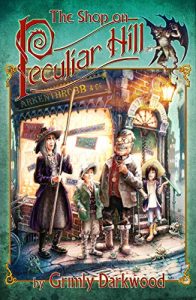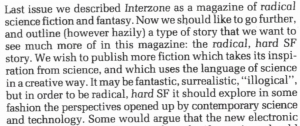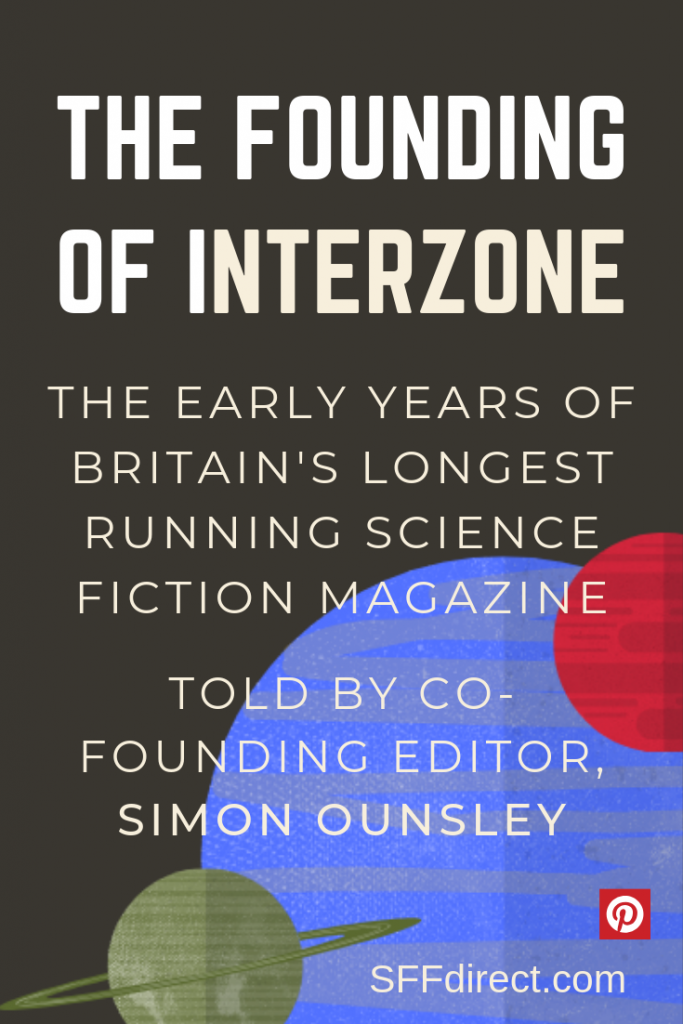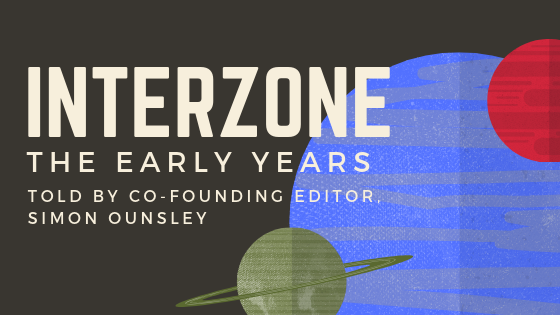This article is about the founding and early years of Interzone, Britain’s longest running and most prestigious Science Fiction (SF) magazine. I met up with Simon Ounsley, one of the Founding Editors, to hear about the birth of this national treasure and what those early years were like.


Simon now writes fantasy stories for children under the name Grimly Darkwood! You can buy his novel, The Shop on Peculiar Hill, on Amazon UK and Amazon US. Aimed at children aged 8 to 12, Simon describes it as ‘a funny, creepy, exciting adventure story’. Book 2 in the series will be out soon. See his website here.
Introduction
The esteemed Editor Gardner Dozois summed up how prestigious Interzone is today. In his annual summation about professional SF magazines of 2017, he wrote:
Interzone is technically not a “professional magazine,” by the definition of the Science Fiction Writers of America (SFWA) because of its low rates and circulation, but the literary quality of the work published there is so high that it would be ludicrous to omit it.
G. Dozois, “Summation: 2017” in The Year’s Best Science Fiction (New York: St.Martin’s Griffin, 2018)
Indeed, Interzone continually wins awards and is ranked up with Analog, Asimov’s and The Magazine of Fantasy and Science Fiction. Today, Interzone is run by Editor Andy Cox, who does a sterling job. But where and how did it all begin?
The founding
In 1981, Eastercon was held in Leeds. Four attendees were David Pringle, Simon Ounsley, Alan Dorey (then chairman of the British Science Fiction Association (BSFA)) and Graham James. David Pringle was a co-chairman of the convention and Simon Ounsley was assisting with the finances. The convention made a profit of £1,300, which Simon states was completely unintentional and purely down to cautious budgeting. At Graham James’ suggestion, the committee agreed to use the money to launch an SF magazine. Simon recalls how controversial this decision was at the time, but in any event, the four men teamed up to start a magazine.
Click here to read SFFdirect’s report of this year’s Eastercon, including interviews with top names in UK SFF publishing.
At the same time, four friends in London were also trying to get an SF magazine off the ground. They were Malcolm Edwards, who worked for SF publisher Gollancz, and SF critics John Clute, Colin Greenland, and Roz Kaveney. They had asked the BSFA if they would publish the magazine and it had declined. However, Alan made David aware of the London proposal and the two groups got together.
As Simon says, this was an ideal match because the Leeds contingent had the money and the London team had the connections. The name of the magazine was suggested by David. It was an imaginary city in the William S. Burroughs novel Naked Lunch.
The initial money didn’t last long. In the first few years the magazine survived because of grants from the Arts Council and Yorkshire Arts Council. There were also generous donations from Sir Clive Sinclair and, later on, Arthur C. Clarke.
The magazine’s content
Simon recalls that there wasn’t always universal agreement on everything. This is not surprising given that eight people were involved and all had equal say. The Leeds contingent wanted to publish a wide range of SF and also non-fiction. They wanted the covers of the magazines to have ‘Science Fiction and Fantasy’ on them. The London contingent, influenced by Moorcock’s editing of New Worlds, wanted the magazine to have a more literary style and no non-fiction. And they didn’t want anything on the cover about fantasy and science fiction.
The latter got their way, and it was only at issue 5 (Autumn 1983) that a compromise of sorts was reached and ‘Imaginative fiction’ was put on the cover. But it was only when the last of the London editors left with issue 12 (Summer 1985) that ‘Science Fiction and Fantasy’ appeared on the cover. Simon recalls that sales then improved markedly because at last readers knew exactly what the magazine was about.
While Interzone is now a science fiction magazine, back then it published both fantasy and science fiction. Simon states they were still doing fantasy when he left in 1988. He told me that in the early days there were not many submissions and most of them were in fact fantasy rather than science fiction. They weren’t the Tolkien-esque sword and sorcery type of stories either. They were generally more a quirky magical realism type of fiction.
A radical magazine
Simon states that the best and most significant story published in his time was ‘The Unconquered Country’ by Geoff Ryman. This was a fantasy story and was featured in issue 7 (Spring 1984). It helped put Interzone on the map and the story was seen as radical by many readers. Indeed the Editorial of issue 7 said ‘Interzone is a magazine of radical science fiction and fantasy’.
The Editorial of issue 8 (Summer 1984) went even further, sending out a call for more ‘radical, hard SF’ stories. This Editorial has gone down in SF history and it’s significance cannot be overemphasized. Here’s the beginning:

The magazine didn’t define what it meant by ‘radical’ but left it open to interpretation. With this Editorial, Interzone began its journey to the more hard experimental type of SF it is known for today.
The issue 8 Editorial was written by David and Colin. Simon recounted with a smile how it was presented to him as a fait accompli. He said that had he known about it before it was published he would probably have objected. He’d have asked them to tone it down because it gave the impression that radical hard SF was all the magazine was interested in and they didn’t want, for example, fantasy any more. So it’s just as well they didn’t consult him about it! What is more ironic is that one of the co-writers was Colin, who had wanted a more literary style of content and who had objected to having anything about SFF on the cover.
Time for optimism
In the issue 19 (Spring 1987) Editorial written by Simon, he mentioned that a lot of the fiction the magazine had been receiving was pessimistic. There were lots of static ‘mood’ pieces where characters would ‘wander aimlessly around some chaotic near future landscape, gazing miserably at cans of baked beans in decaying supermarkets’. In the Editorial, Simon called for a more upbeat type of story with more plot and story in it. Looking back on it now, Simon reflects:
The writing which shortly began to emerge, in the form of radical hard SF and cyberpunk, was in general more optimistic and certainly more fun – it could hardly be less so! Interzone can’t lay claim to cyberpunk, though in his preface to Mirrorshades, the cyberpunk anthology, Bruce Sterling described the magazine as ‘a hotbed of cyberpunk activity’. But it seems reasonable to suppose that the radical hard sf which eventually emerged drew significant inspiration from David and Colin’s famous Editorial and I like to think that my suggestion in issue 19 to think about what life might be like in the future if we ‘get lucky’ might have had some influence too.
Simon Ounsley, From an email sent soon after our meeting.
The nuts and bolts
It was fascinating to hear from Simon about how things worked in the early years of Interzone. It was an astonishing achievement that eight people in two different locations set up and successfully ran a magazine. They all had jobs and ran the magazine in their spare time. And this was before the internet or mobile phones when everything had to be posted or hand delivered. This is why it was even more important to get a British magazine going. Because for British writers who previously submitted to the US market, it had been an administrative nightmare and costly.
None of the eight took any money for their labours either. Simon was responsible for the finances and even used to pay the postage himself when sending out back issues to people!
At any one time, there were two or three Editor addresses to which submitters could send their story. The person receiving it read it first. If it had any promise at all it would be sent round all eight Editors to read and grade. The grading system was simple but fit for purpose. Each story could be graded from two ticks (very ‘good’) to two crosses (very ‘bad’). And you could straddle a boundary if you felt it was borderline between two categories. Here is an example of a scoresheet showing three lines of reviewers:

Onto another era
Over time, the eight Editors left one by one. When Colin stepped down after issue 12 there were only David and Simon remaining. Simon left after issue 24 (Summer 1988) when ill health forced him to step down.
David continued to develop the magazine with the support of his wife Ann and others until he eventually moved on to other things after issue 193 in early 2004. The magazine was taken on by Editor Andy Cox of TTA press, then publisher of The Third Alternative (which became Black Static). Simon recalls, ‘Many people helped to launch and develop Interzone but David Pringle was of course the primary figure. It would not have achieved what it did without his hard work and dedication over more than 20 years.’
Further information
You can click here to read an interview with David Pringle from 1997 where he talks about the birth of Interzone and his time at the magazine.
Many back issues of Interzone are available on the Internet Archive .
SFFdirect would like to thank Simon Ounsley very much for his time, and wishes him every success with his novel The Shop on Peculiar Hill.
Please tell me your thoughts in the comments. And don’t forget to subscribe to our newsletter!



Only registered users can comment.